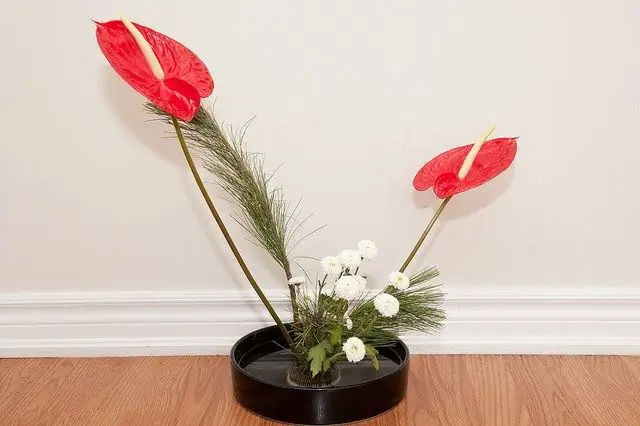Ikebana is the Japanese art of flower and plant composition based on the principle of exquisite simplicity. Each of its elements has a special meaning, and their combination is associated with a particular season or expresses the future, present or past.

Materials for composing ikebana
To compose ikebana, a low capacity is required, which will serve as the basis for composing the composition. This can be a ceramic bowl, a small vase, a tray or saucer, or even a piece of bark.
When composing ikebana, preference is given to monochromatic vessels, the shade of which is combined with the colors chosen for the composition. For a bouquet of wildflowers, a small basket or a small earthenware vase is suitable. Noble garden flowers: chrysanthemums, roses and lilies look harmoniously in porcelain or glass containers.
If the plants are colorful and vibrant and are the main element of the composition, then choose a modest one-color container. When you need to make a bouquet in a beautiful and graceful vase, then it is she who will become the main accent of the ikebana, so pick up dim flowers and branches.
Ikebana can be made not only from flowers, but also from the most unexpected plants, for example, using common cauliflower, decorating the composition with sprigs of dill and parsley. Often the composition is complemented by fruits and twigs with berries. Choose unusual material and use unusual shapes.
In the original, ikebana is made up on a special metal stand - kenzan, but it can be easily replaced with other mounts. So it is very convenient for this purpose to use a porous floristic sponge - piaflor (for fresh flowers and plants). If you are going to make ikebana from artificial elements, dried flowers or dry branches, then you can use a piece of foam, plasticine or pour wet sand or expanded clay on the bottom of the container.
Composition rules
The art of composing ikebana is subject to several rules. The main one is a combination of three elements symbolizing earth, man and sky.
Place a sponge in your chosen vase and pour in some water. Cut the stems of the plants with a clean knife at an angle and remove all the leaves at the bottom of the stem.
In the middle of the sponge, stick the largest branch or flower, it will symbolize the sky (sin). The second element - a person (soe) - should be 2/3 shorter than the first. Place it in a vase and tilt it in the same direction as the first branch - sin. The third element of the composition - earth (hikae) - is the shortest, usually the size of the flower is 2/3 of the soe element. It should be placed in front of the bouquet and moved slightly so that the flower is directed in the opposite direction from the shin and soe. All 3 elements must form a kind of triangle.
Complete the composition with plant material. Cover the surface of the bowl or vase with moss, add twigs and small flowers, put some beautiful stones or a small snag.






